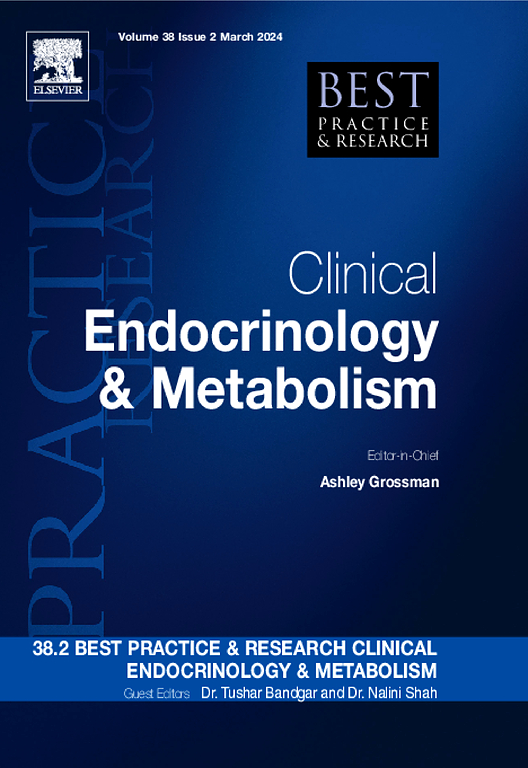The interplay between thyrotropic axis, neurological complications, and rehabilitation outcomes in patients with traumatic brain injury
IF 6.1
1区 医学
Q1 ENDOCRINOLOGY & METABOLISM
Best practice & research. Clinical endocrinology & metabolism
Pub Date : 2025-05-01
DOI:10.1016/j.beem.2025.102001
引用次数: 0
Abstract
Traumatic brain injury (TBI) is a leading cause of mortality and long-term disability, with its pathophysiology encompassing both primary mechanical damage and secondary neuroinflammatory, metabolic, and biochemical alterations. These complex mechanisms contribute to the observed heterogeneous clinical outcomes, including neuroendocrine dysfunctions, post-traumatic seizures, and disorders of consciousness (DoC). Thyroid hormones (THs) play essential roles in synaptic plasticity, neurogenesis and neuronal homeostasis, and the hypothalamic-pituitary-thyroid (HPT) axis has recently emerged as a potential acute and chronic modulator of neurological and functional recovery following TBI, thereby hinting at the potential involvement of THs in post-TBI outcomes. While evidence suggests that alterations in the HPT axis may influence susceptibility to seizures, progression of DoC, and rehabilitation outcomes, an increased blood-brain barrier permeability in concert with dysregulated deiodinase activity and expanding oxidative stress have all been proposed as mechanisms linking THs to post-TBI neurological complications. This review aims to summarize current evidence on the potential role of the thyrotropic axis in neurological and rehabilitation outcomes following TBI.
外伤性脑损伤患者的促甲状腺轴、神经系统并发症和康复结局之间的相互作用。
创伤性脑损伤(TBI)是导致死亡和长期残疾的主要原因,其病理生理包括原发性机械损伤和继发性神经炎症、代谢和生化改变。这些复杂的机制导致了观察到的异质临床结果,包括神经内分泌功能障碍、创伤后癫痫发作和意识障碍(DoC)。甲状腺激素(THs)在突触可塑性、神经发生和神经元稳态中起着至关重要的作用,下丘脑-垂体-甲状腺(HPT)轴最近被发现是脑外伤后神经和功能恢复的潜在急性和慢性调节剂,从而暗示了THs可能参与脑外伤后的预后。虽然有证据表明HPT轴的改变可能影响癫痫发作的易感性、DoC的进展和康复结果,但血脑屏障通透性增加、脱碘酶活性失调和氧化应激扩大都被认为是与tbi后神经系统并发症相关的机制。这篇综述旨在总结目前关于促甲状腺轴在TBI后神经和康复预后中的潜在作用的证据。
本文章由计算机程序翻译,如有差异,请以英文原文为准。
求助全文
约1分钟内获得全文
求助全文
来源期刊
CiteScore
11.90
自引率
0.00%
发文量
77
审稿时长
6-12 weeks
期刊介绍:
Best Practice & Research Clinical Endocrinology & Metabolism is a serial publication that integrates the latest original research findings into evidence-based review articles. These articles aim to address key clinical issues related to diagnosis, treatment, and patient management.
Each issue adopts a problem-oriented approach, focusing on key questions and clearly outlining what is known while identifying areas for future research. Practical management strategies are described to facilitate application to individual patients. The series targets physicians in practice or training.

 求助内容:
求助内容: 应助结果提醒方式:
应助结果提醒方式:


